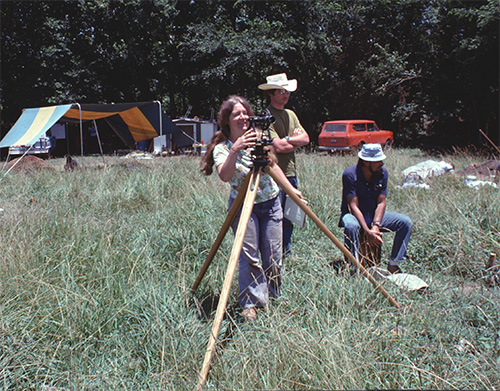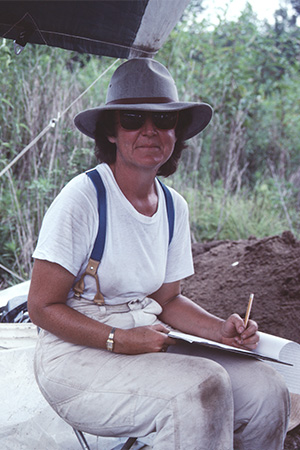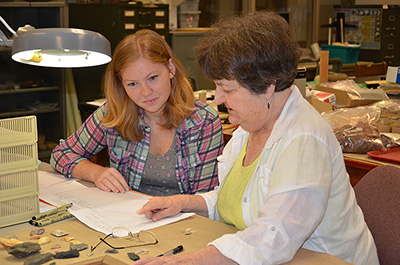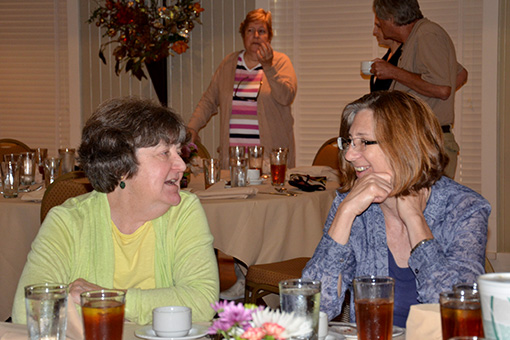George Sabo III, Mary Beth Trubitt, and Kathy Cande

Dr. Ann M. Early joined the Arkansas Archeological Survey (ARAS) in 1972 as research station archeologist at Henderson State University (Arkadelphia), following completion of her PhD degree at the University of Massachusetts-Amherst. Her dissertation examined the Upper Mississippian Occupation of the Fox River Valley in Illinois. Before that, Ann completed a bachelor’s degree at Beloit College and a master’s degree at the University of Wisconsin-Milwaukee. Ann succeeded Hester A. Davis as State Archeologist in 1999 and served in that position until her retirement in June 2020.
Throughout her long career with ARAS, Ann conducted extensive research on Caddo Indian culture history in and south of the Ouachita Mountains region of southwest Arkansas, authoring several important books, book chapters, and journal articles.

An initial foray into studying the archeology of the region involved examination of archival, artifact collection, and literature sources to develop a series of chronologically ordered Caddo settlement models for the Ouachita River basin, poorly known at the time (Early 1982). A contemporaneous CRM survey and testing project along the Caddo River provided an opportunity to further explore those models, including the first investigations of novaculite mining as one prominent element of Caddo land use patterns in the Ouachita Mountains (Early and Limp 1982). Her first major excavation project, designed in part to refine those models, took place at the Standridge site, where she supervised excavations conducted in 1975 and 1976 as part of the Arkansas Archeological Society training program and University of Arkansas field schools. Initially considered a minor habitation site, Ann documented a 14th to mid-15th century shift from residential occupation to service as a local socioreligious center featuring specialized buildings used for ritual performances (Early 1988).

In 1978, ARAS was invited by the National Park Service (NPS) to develop one of the first “State Plans” for archeological site conservation and research, as part of the NPS Resource Protection Planning Process, an early response to 1960s era federal historic preservation legislation. Ann and Frank Schambach (Southern Arkansas University station archeologist) teamed up to synthesize the existing literature and develop a research agenda for the Southwest Arkansas study unit (Schambach and Early 1982). ARAS was also invited in 1984 to develop a series of cultural resource overviews intended to cover the entirety of the multi-state Southwest District of the U.S. Army Corps of Engineers. Ann joined UAF research station archeologist George Sabo III to develop the first volume, devoted to the Ozark and Ouachita Mountain regions of Arkansas and Oklahoma, applying a novel “adaptation type” framework for synthesizing regional information on prehistoric and historic cultural sequences (Sabo et al. 1990). Both studies continue to serve as important general references for those areas.

In 1986, the Arkansas Highway and Transportation Department discovered an extensive distribution of archeological materials within the right-of-way of a bridge replacement site along Saline Bayou in the Ouachita River Valley. Verification of the significance of the site via test excavations led to a rare opportunity to investigate the Hardman site in its entirety. The farmstead—containing dwellings and numerous work areas with support facilities surrounded by a light fence or palisade—was occupied ca. AD 1400–1700. A major series of features included several hearths used in saltmaking. The project report (Early 1993) not only provided major refinements to the local cultural sequence but also produced the first major investigation contextualizing Caddo saltmaking within community settlement and subsistence organization.

Throughout much of her tenure as the Survey’s HSU research station archeologist, Ann served as Certification Program Coordinator for the Arkansas Archeological Society training program. She consequently directed more of the annual two-week training programs than many of her colleagues, and also succeeded in producing publications for most of those projects. One example is the 1995 training program conducted at a small cluster of historic and prehistoric sites located in the Winding Stair recreational area of the Ouachita National Forest. Excavations at the Winding Stair component of this site cluster uncovered the remains of a late 15th century building that closely resembled Fort Coffee phase buildings in the Arkansas River Valley and also exhibited architectural as well as use-history evidence comparable to ritual structures excavated two decades earlier at Standridge (Early 2000).
In addition to her extensive list of projects centering on Caddo settlement and subsistence organization in the Ouachita Mountains, Ann directed a significant part of her research to the study of Caddo ceramics. While at HSU, she oversaw the curation and management of the HSU Museum as well as the Joint Educational Consortium Hodges Collection. This collection of some 38,000 artifacts and other materials, mostly from Caddo sites in southwest Arkansas, had been assembled during the 1930s and 1940s by Thomas and Charlotte Hodges of Bismarck, Arkansas and acquired during the 1970s by the Joint Educational Consortium of Ouachita Baptist University and Henderson State University in Arkadelphia. Among the items represented in the collection are some 1300 whole ceramic vessels. As part of her long-time examination of these and other Caddo decorated ceramics Ann reconstructed a series of “grammars” or rule-based procedures that track the application of decorative variations aligning with discrete communities. Perhaps the best example of this analysis is reflected in her study of some 251 carinated bowls from the HSU Museum and Hodges collections, all representing the type Friendship Engraved var. Freeman (Early 2012). In addition to this contribution, Ann worked for many years with colleague Frank Schambach to develop the so-called “collegiate” system for classifying Caddo ceramic decorative treatments that occur systematically on specific areas of vessel surfaces. Though applied in several specific studies (e.g., Early 1988, 1993, 2000; Kelley 1997; Schambach 1990) production of a comprehensive analytic guide to this system remains the focus of Ann’s ongoing research in collaboration with Mary Beth Trubitt.

Venturing into the realm of ethnohistoric studies, Ann contributed overviews of Caddos in the Trans-Mississippi South (Early 2000) and the French-Chickasaw War in the Mississippi Valley (Early 2011).
Ann’s participation in two other large scale, collaborative efforts deserve mention. Throughout much of the 1980s and 1990s, Charles Hudson (University of Georgia) and a large team of colleagues undertook a major effort to reexamine the route of Hernando de Soto’s 1539–1543 expedition throughout the Southeast and interactions with the numerous indigenous communities the Spaniards contacted (Hudson 1997). A major series of encounters took place with Caddo communities in the western Ouachita Mountains, a portion of the route for which Ann ably assessed the archeological evidence (Early 1993). A second project is the UAF research station’s long-term investigation of the Carden Bottoms site in the Arkansas River Valley, an early 17th-century coalescent village that included some households whose ancestry traces to Caddo groups in the Ouachita Mountains region (Sabo et al. 2020).
Beyond research, Ann contributed extensively to other programs at the Survey and at many other institutions and agencies.

During her 27-year career at Henderson State University, Ann taught a wide range of classes helping to fulfill several program requirements, including Introduction to Cultural Anthropology, Introduction to Physical Anthropology and Archaeology, North American Archaeology, North American Indians, and World Cultures, in addition to frequent individual study offerings. As mentioned, she managed the university’s museum and JEC Hodges Collection, which contributed materials displayed on a rotating basis at the libraries on both campuses in Arkadelphia. Ann directed archeological investigations and reconstruction efforts at HSU’s J. E. M. Barkman House site in preparation for its nomination to the National Register of Historic Places. She also served a term on the faculty senate and contributed to numerous other HSU committees.
In addition to serving as the Certification Program Coordinator for the Arkansas Archeological Society training program, Ann taught numerous seminars including the Beginner’s Orientation for the past several years. She has been a driving force in the initial creation and subsequent development of the goal-based training philosophy on which the program is organized.

Serving as State Archeologist from 1999 to 2020, Ann consulted regularly and extensively with several offices within the Arkansas Department of Heritage and with other state agencies, including the Department of Parks, Heritage, and Tourism; the Arkansas Game and Fish Commission; the Arkansas Forestry Commission; the Arkansas Department of Transportation, and the Central Arkansas Library System for whom she served as editor for numerous submissions to the online Encyclopedia of Arkansas. She also worked closely with several federal agencies with Arkansas programs, including the U.S. Army Corps of Engineers, the Forest Service—including the Ouachita and Ozark-St. Francis National Forests—and the National Park Service. Part of this service included advisory board participation as well as teaching a large number of Cultural Resource Technician training workshops. One of Ann’s most noteworthy achievements as State Archeologist was managing a series of projects funded by grants awarded by the National NAGPRA office to complete the repatriation process for all subject materials in ARAS collections.

Professional service was also an important component of Ann’s long career. She was a decades-long member of the Society for American Archaeology’s Committee on Public Archaeology and, as part of her long-term interests in combatting pseudoscience, she also contributed to the SAA Committee on Creationism. Ann represented the Arkansas State Division of the American Association of University Women, and was a long time member and president of the National Association of State Archaeologists. Ann served as President-elect of the Southeastern Archaeological Conference (SEAC) in 2009–2010 and President from 2011–2012. She also served SEAC as Executive Officer II from 2000–2003 and had several committee roles as well.
Ann also served elected terms for the Arkansas Historical Association (Board of Trustees, 1995; Vice-President, 1996–1999; President, 2000–2004; Past-President, 2005–2006), the Arkansas Humanities Council, the Historic Preservation Alliance, and the State Review Board for Historic Preservation.
Back at ARAS, Ann served numerous stints on the Personnel Committee and helped write the Committee’s operational Personnel Document. She was an active support person and advisor for numerous research station projects across the state, and helped foster several collaborative efforts among various stations.

